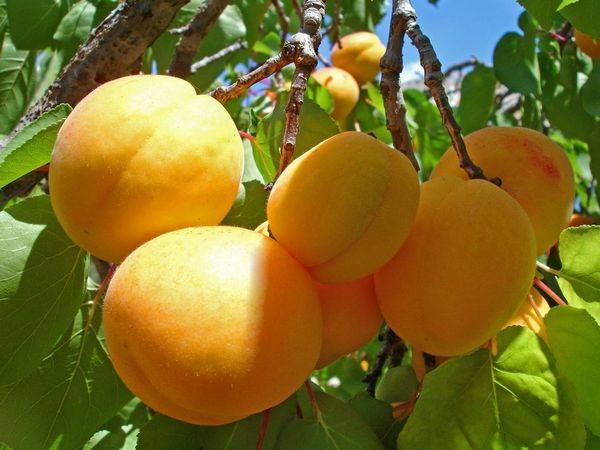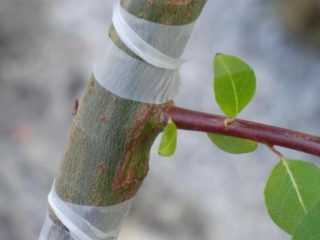Content
Thanks to the efforts of employees of agricultural breeding companies, new varieties with improved characteristics are born every year. One of the latest developments is the Lel apricot, which is endowed with excellent resistance to adverse weather conditions and requires little care.
History of selection
A fruit tree seedling in the 2nd-3rd generation was bred in 1986 by specialists of the Main Botanical Garden L.A. Kramarenko and A.K. Skvortsov using the free pollination method. Despite the fact that the culture appeared in the mid-80s, it was included in the Register of Breeding Achievements only in 2004.
Description of culture
The Lel apricot tree is not a spreading tree, 3 m high. From a distance, a photo of the Lel apricot tree resembles a mushroom. Thanks to this structure, it is easier for gardeners to care for the plant and harvest. The leaves are shaped like a tapering ellipse and are medium in size with serrated edges.The leaf blades are smooth on top and covered with short white fluff underneath. In autumn, when trees prepare to go dormant, the color of the leaves changes from green to shades of red.
The flowers are light pink, 3 cm in diameter, and emit a delicate, pleasant aroma. The fruits weigh 20 g, flattened on the sides, covered with smooth thin skin. Thanks to a unique combination of sugars and acids, apricots have a pleasant taste, tender flesh and a rich apricot aroma. The large stone is not attached to the pulp.
The State Register recommends Lel apricot for cultivation in the central regions. However, in practice, this type of apricot, provided it has good shelter, grows in some northern regions.
Characteristics
When choosing a fruit tree, you need to carefully study all the features of the variety. The characteristics of the Lel apricot include the following subparagraphs.
Drought resistance, winter hardiness
The heat-loving fruit tree can easily withstand the longest droughts. A distinctive feature of the variety is resistance to cold. Thus, even young trees, provided proper shelter, can withstand frosts of up to 300C. Apricots are not afraid of return frosts of -1...-30C. Due to this feature, the Lel apricot in Siberia is one of the few types of heat-loving trees that bear fruit annually.
Pollination, flowering period and ripening time
The self-fertility of the Lel apricot is the main highlight of the heat-loving crop.The flowers of a fruit tree consist of a stamen, covered with pollen, and a pistil, which allows the crop to self-pollinate.
At the same time, apricots also have flowers that require cross-pollination. To obtain maximum yield, you need to plant 2-3 fruit trees on the site. The best pollinators of the Lel apricot are the Aquarius and Alyosha varieties. If there is no free space for so many trees, you can plant one, but the harvest will be smaller. Pollination of the Lel apricot depends little on bees and bumblebees, since during flowering the insects are still inactive.
Apricot Lel belongs to the group of early varieties. Despite the rapid growing season, frosts during the flowering period are extremely rare, which allows gardeners to annually collect generous harvests of apricots even in the northern part of the country. Depending on the climate of the growing region, the ripening period of the Lel apricot falls in the second or third ten days of July.
Productivity, fruiting
The tree bears its first harvest 3-4 years after grafting or planting in a permanent place. The fruits are borne both on single flowers and on flowers collected in a bouquet. A photo of the Lel apricot during the flowering period is simply mesmerizing with its beauty.
Area of application of fruits
Apricots of the Lel variety are universal: the fruits are consumed fresh, made into jam, compote, and dried. Regardless of the processing method, fruits have dense pulp, a distinct smell and color. The description of the Lel apricot contains information that fruits with a rich content of nutrients can be used to prepare puree for complementary feeding.
Resistance to diseases and pests
The Lel variety has average immunity to clasterosporiosis and is practically not attacked by aphids - only 1% of trees suffer from insect attack. Since resistance to most diseases is average, growing the Lel apricot variety is successful only if it is systematically treated with appropriate preparations.
Advantages and disadvantages
It is these factors that people pay attention to when choosing a variety of fruit tree. The advantages of the Lel apricot variety are:
- Frost resistance
- Early ripening.
- Compactness.
- Good keeping quality.
- High taste qualities.
The disadvantages of a fruit tree include:
- Small fruit size.
- Large stone - 10-12% of the size of the fruit.
- Average yield.
Landing Features
Planting a Lel apricot is very similar to planting any other fruit tree, but it has several features that need to be taken into account so that the tree grows quickly and pleases with a bountiful harvest.
Recommended timing
In the central regions, apricots are planted in early spring, when sap flow begins. The optimal temperature for planting apricots at night is +10…+120C. By winter, the seedling forms a powerful root system and tolerates it well.
Autumn planting is possible only when at least 2 months remain before the onset of stable cold weather. And since the weather has been surprising with surprises lately, it is not always possible to accurately determine the appropriate time for planting, which can lead to a deterioration in the condition of the seedlings and their death.
Choosing a suitable location
Sunny areas protected from drafts and north winds are suitable for planting a heat-loving tree. Apricot grows best in light, well-drained soil.Chernozem, sandy loam, and loamy soils are ideal as a comfortable living environment.
It is not recommended to plant apricots on sandy or clay soils. In the first case, the tree is subject to burns and aging, and in the second - to diseases. If there is no corresponding location, you can create it manually. To do this, make a 70 cm high embankment on a free 2 m of land, and then plant a seedling on the south side.
What crops can and cannot be planted next to apricots?
The southern tree does not like to share its territory with other plants, so it is better to plant it in a separate area. It is especially not recommended to plant apricot next to apple, plum, pear, cherry, walnut, peach and cherry. Currants and raspberries should not be planted among bushes near a fruit tree.
Selection and preparation of planting material
For the laudatory reviews about the Lel apricot to be true, the first thing you should do after deciding to acquire apricot trees is to search for a trusted seller. As a rule, the likelihood of buying a bad seedling in local nurseries is much lower than from a visiting reseller.
For planting, you should choose one or two-year-old trees with a powerful root system, the shoots of which are white or cream-colored when cut. The bark should be smooth and elastic: peeling, spots and rot are signs of serious diseases that prevent the tree from developing normally. Good planting material has wood colored light green.
Landing algorithm
For the landing to be successful, all actions must be carried out according to a clearly established plan. The garden manipulation scheme looks like this:
- Preparing the planting hole. In autumn or spring (3 weeks before planting), a hole 70 cm deep is dug in the selected area. Then a layer of drainage material is laid and covered with a mixture of fertile soil and 1.5-2 buckets of humus. Add 1 liter of ash or complex fertilizers with a high content of phosphorus and potassium.
- The seedling is soaked for a day in an industrial or biogrowth stimulator, and then the rhizome is examined and damaged or diseased shoots are removed. The length of the roots is shortened by 2-3 cm.
- Dip the measles system into a container with thick clay mash and let it dry.
- Stepping a little to the side from the center of the embankment, drive in a peg, the length of which is 20 cm longer than the length of the apricot.
- The tree is placed in a hole, the roots are spread out to the sides and covered with soil. The root collar should be 5 cm above the soil level.
- The soil is lightly compacted and watered abundantly. A little later, when the soil dries out, the tree trunk circle is mulched.
- A protective screen is placed on the sunny side for 2-3 days.
Subsequent care of the crop
In order for a tree to show its potential, the gardener needs to systematically carry out a number of gardening manipulations. Apricot care includes:
- Watering. Water is added in large portions into the depression around the trunk as the soil dries out.
- Feeding. In spring, apricots are fed with organic matter, and in summer – with complex mineral fertilizers.
- Trimming. In spring, excess, damaged and diseased branches are removed from the crown.
- Loosening and mulching.
Diseases and pests, control and prevention measures
Growing Lel apricot in the Moscow region is impossible without regular spraying, since due to changeable weather and geographical location, seedlings suffer from microorganisms and insects.
Apricot suffers from moniliosis, bacterial and perforated spot, Vals fungus, verticillium, and gum disease. To prevent the development of pathogenic microorganisms and cure already diseased specimens, trees are sprayed with copper-containing preparations: Bordeaux mixture, Horus, Mikosan.
Treatment with an insecticide or planting medicinal and spicy herbs with a strong odor next to the seedlings will help protect the crop from leaf rollers, codling moths and aphids. These include thyme, dill, marigolds, lavender, and calendula.
Conclusion
Apricot Lel is an early variety resistant to adverse conditions with excellent taste. Planting and caring for the Lel apricot is extremely simple and does not take much time, which allows very busy summer residents to grow the tree.
Reviews
Reviews of Lel apricot in the Moscow region are preferably positive. Here are some of them:
You can see that gardeners’ reviews of the Lel apricot fully confirm the stated characteristics, which dispels all doubts about its veracity.

















